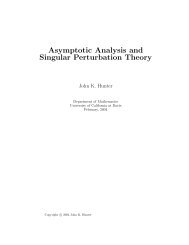Bounded Linear Operators on a Hilbert Space
Bounded Linear Operators on a Hilbert Space
Bounded Linear Operators on a Hilbert Space
You also want an ePaper? Increase the reach of your titles
YUMPU automatically turns print PDFs into web optimized ePapers that Google loves.
Weak c<strong>on</strong>vergence in a <strong>Hilbert</strong> space 207<br />
oscillate more and more rapidly as n → ∞. If a functi<strong>on</strong><br />
f(x) =<br />
∞<br />
an sin nπx<br />
n=1<br />
in L2 ([0, 1]) is represented by its sequence (an) of Fourier sine coefficients, then this<br />
example is exactly the same as Example 8.38.<br />
The sequence (fn) defined by<br />
√<br />
n if 0 ≤ x ≤ 1/n,<br />
fn(x) =<br />
0 if 1/n ≤ x ≤ 1,<br />
c<strong>on</strong>verges weakly to zero in L2 ([0, 1]). To prove this fact, we observe that, for any<br />
polynomial p,<br />
<br />
1<br />
<br />
<br />
<br />
p(x)fn(x) dx<br />
<br />
0<br />
= √ <br />
<br />
<br />
1/n <br />
<br />
<br />
n p(x) dx<br />
0 <br />
<br />
1<br />
<br />
<br />
≤ √ <br />
n n<br />
<br />
1/n <br />
<br />
p(x) dx<br />
<br />
since, by the c<strong>on</strong>tinuity of p,<br />
n<br />
1/n<br />
0<br />
p(x) dx = p(0) + n<br />
1/n<br />
0<br />
→ 0 as n → ∞<br />
0<br />
{p(x) − p(0)} dx → p(0) as n → ∞.<br />
Thus, 〈p, fn〉 → 0 as n → ∞ for every polynomial p. Since the polynomials are<br />
dense in L2 ([0, 1]) and fn = 1 for all n, Theorem 8.40 implies that fn ⇀ 0. The<br />
norms of the fn are bounded away from 0, so they cannot c<strong>on</strong>verge str<strong>on</strong>gly to zero.<br />
In this case the functi<strong>on</strong>s fn have a singularity that c<strong>on</strong>centrates at a point.<br />
The sequence (fn) defined by<br />
<br />
1 if n < x < n + 1,<br />
fn(x) =<br />
0 otherwise,<br />
c<strong>on</strong>verges weakly, but not str<strong>on</strong>gly, to zero in L 2 (R). In this case, the functi<strong>on</strong>s fn<br />
escape to infinity. The proof follows from the density of functi<strong>on</strong>s with compact<br />
support in L 2 (R).<br />
As the above examples show, the norm of the limit of a weakly c<strong>on</strong>vergent<br />
sequence may be strictly less than the norms of the terms in the sequence, corresp<strong>on</strong>ding<br />
to a loss of “energy” in oscillati<strong>on</strong>s, at a singularity, or by escape to<br />
infinity in the weak limit. In each case, the expansi<strong>on</strong> of fn in any orth<strong>on</strong>ormal<br />
basis c<strong>on</strong>tains coefficients that wander off to infinity. If the norms of a weakly<br />
c<strong>on</strong>vergent sequence c<strong>on</strong>verge to the norm of the weak limit, then the sequence<br />
c<strong>on</strong>verges str<strong>on</strong>gly.
















